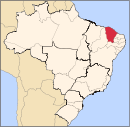|
Santana do Cariri
Santana do Cariri is a municipality in the state of Ceará in the Northeast region of Brazil.[2][3][4][5] It is located in the immediate and intermediate region of Juazeiro do Norte, as well as in the region of influence of Juazeiro do Norte.The municipality has 807 km2. It is estimated that in 2021 its population has reached 17,726 thousand inhabitants, according to the IBGE. It has the title of “The Cearense Capital of Paleontology ''. HistoryIt was originally called Brejo Grande, a place inhabited by native tribes of warriors called Buxixés, Tapuias who dominated, in addition to Araripe, bordering lands of Pernambuco. Its origin dates back to the end of the 17th century, when the brothers João Alves Feitosa and José Cavalcante coming from Casa da Torre (Bahia) requested and obtained land on the banks of the Brejo Grande Creek. Given the geologically favorable conditions, not only in relation to the livestock, but above all to agriculture, there was a rapid development of the stronghold attracting new residents to the region with the flux of residents a chapel was erected under the invocation of Senhora Santana, in the same place of the current Matriz. From this pioneering convergence, the village and the adjacent settlements would be born forming a rapid flowering stage. The elevation of the camp to the category of village took place according to Provincial Law nº 2096, of November 26, 1885. The elevation to the category of municipality took place on December 20, 1938, still under the name of Santonópole, in the form of the Decree-Law nº 448. It currently has six districts: Santana do Cariri (Headquarters) Dom Leme (1987), Brejo Grande (1912), Anjinhos (1963), Araporanga (1938) and Pontal da Santana Cruz (1990) and two districts: Santana do Cariri (headquarters) and Inhumas (becomes a neighborhood in 2014 by municipal law n° 737). ToponomySantana do Cariri was also called Brejo Grande, Santana do Araripe, Santana do Cariri, Santanópole and finally returned to the traditional name on November 22, 1951, calling Santana do Cariri. GeographyVegetationThe municipality's vegetation ranges from xeromorphic tropical evergreen forest, Carrasco, tropical rain evergreen rainforest to rain-cloud tropical evergreen rainforest. ClimateThe climate ranges from mild semi-arid hot tropical to sub-humid hot tropical. The rainy period occurs generally between January and May. Culture The municipality has as its religious symbol Senhora Santana, as well as the young Benigna Cardoso da Silva, better known as the heroine of chastity. It houses 19 public municipal schools, 2 (two) private schools and 1 state school. The municipality has an archaeological site (Brazilian rock art) of historical and tourist interest. Santana do Cariri also stands out for the sale of products made manually at the Santanense Association of Support to the Craftsman. Tourists can buy typical handicrafts made from lace, embroidery, leather, ceramics and painting. In terms of gastronomy, emphasis is given to chicken à cabidela and baião-de-two with pequi. It stands out for having a vast paleontological site, where several species of extinct animals have already been discovered. It houses the Museum of Paleontology of the Regional University of Cariri, the Casarão Cultural Felinto da Cruz Neves and Generosa Amélia da Cruz 1st female mayor of Santana, 1st of Ceará and 2nd of Brazil. Centenary church of Senhora Sant'Ana" in neoclassical style, Pontal da Santa Cruz at 750m above sea level with viewpoint and restaurant in Chapada do Araripe. Historic sites
Events
See alsoReferences
|
||||||||||||||||||||||||




